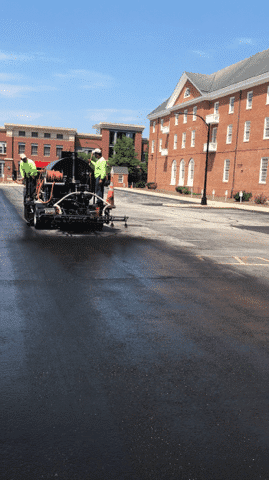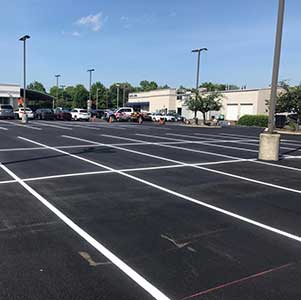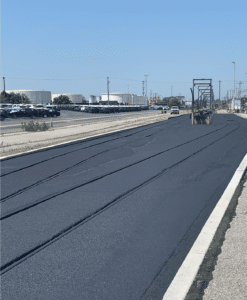Updated: 07/05/2024
With the arrival of spring, many individuals are preparing for outdoor projects. As you begin tidying up the exterior of your property, remember to inspect your paved driveway. If your driveway has aged, it might be time to reseal it. However, not everyone is familiar with sealcoating. This article addresses the common question, “What does sealcoating do?”
What is Sealcoating?
To understand what sealcoating does, it is essential first to grasp what sealcoating is.
Sealcoating, or pavement sealing, involves applying a protective coating to asphalt-based pavement to shield it from the elements. This coating is composed of crude oils, which serve as the initial binder for asphalt, holding the aggregate and stone together.
Why Do You Need Sealcoating?
Sealcoating acts as preventative maintenance that extends the life of your pavement. It is similar to the paint on the exterior of your home. Over time, paint can crack and peel, necessitating a fresh coat to maintain its appearance.
As time passes, your pavement is exposed to the elements and can incur damage, much like the exterior of your home. This damage can cause your pavement to deteriorate and crumble.
Various elements contribute to pavement damage over time, including:
- Water and varying temperatures
- UV rays from the sun
- Salt treatments during winter
- Gas, oil, and other leaking chemicals from vehicles
- The load-bearing weight of cars and trucks
The oil in the pavement binder eventually breaks down and dries up, causing the pavement to lose its integrity. Sealcoating replenishes this vital component of the asphalt, thereby extending its lifespan.
Benefits of Sealcoating
Just as a new paint job refreshes the exterior look of a home or business, sealcoating restores your pavement to its original black luster, giving it a visible facelift.
Resealing your asphalt enhances its appearance and protects it from water damage. Water is the primary enemy of asphalt, especially in climates with significant temperature fluctuations. It can seep into the most minor cracks in the pavement, expanding as it freezes and widening these cracks.
Sealcoating also prevents other chemicals from penetrating the asphalt. Chemicals from vehicles and road treatments, such as salt, can damage asphalt. When applied, sealcoating forms a barrier between the asphalt and these chemicals.
If left untreated, your driveway or parking area will eventually deteriorate. As cracks enlarge, larger sections may give way, resulting in potholes and depressions. This type of damage can harm vehicles and incur repair costs.
Maintaining your asphalt is more economical than repaving it entirely. Installing asphalt is a significant investment, and protecting it is cost-effective.
How Often Should You Sealcoat?
It is recommended to reseal your pavement every three to five years, depending on your environment and traffic flow.
You can also visually assess when your asphalt needs attention. As the binder breaks down or oxidizes, your asphalt will turn grey. Additionally, you may notice small cracks forming when you inspect your driveway or parking lot. When these signs appear, it is time to consider resealing.
Understanding the importance of sealcoating and its role in maintaining your pavement can help you make informed decisions about your property. Regular maintenance ensures the longevity and durability of your asphalt surfaces.
FAQ
Q: What is the best time of year to sealcoat?
A: The best time to sealcoat is during warmer months, typically late spring to early fall when temperatures are above 50°F.
Q: How long does sealcoating last?
A: Sealcoating typically lasts three to five years, depending on environmental conditions and traffic flow.
Q: Can sealcoating fix cracks and potholes?
A: Sealcoating can fill small cracks, but larger cracks and potholes require separate repairs before applying the sealcoat.







